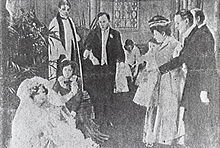The Fatal Wedding
| The Fatal Wedding | |
|---|---|

Still from the film
|
|
| Directed by | Raymond Longford |
| Produced by | Charles Cozens Spencer |
| Written by |
Raymond Longford Lottie Lyell |
| Based on | play by Theodore Kremer novel by R. M. Clay |
| Starring |
Raymond Longford Lottie Lyell |
| Cinematography | Arthur Higgins |
| Edited by | Arthur Higgins |
|
Production
company |
Spencer's Pictures
|
| Distributed by | Spencer's Pictures |
|
Release date
|
24 April 1911 |
|
Running time
|
3,500 feet |
| Country | Australia |
| Language |
Silent film English intertitles |
| Budget | £360 or ₤600 (Longford estimate) or £4,000 |
| Box office | ₤18,000 (est.) |
| The Fatal Wedding | |
|---|---|

Poster from early Australian production of play
|
|
| Written by | Theodore Kremer |
| Date premiered | 1901 |
| Original language | English |
| Genre | melodrama |
The Fatal Wedding is a 1911 Australian silent film directed by Raymond Longford based on a popular American stage melodrama which he and Lottie Lyell had toured around Australia.
It was Longford's debut feature as director and one of the most popular Australian movies of its day. It is considered a lost film.
An adventuress, Cora Williams is in love with Howard Wilson, even though he is happily married to Mabel, and they have small children. Cora gets a man called Curtis to pretend to be in love with Mabel and engineers a situation where Howard walks in on them and gets the wrong impression. It works, Howard divorces Mabel and gets custody of their children Jessie and Frankie. Mabel winds up abducting them.
Five years later Cora discovers Mabel living in poverty with the children. She tries to poison Mabel and frame Jessie on a charge of theft but is unsuccessful. Howard and Mabel eventually reconcile and live with their children.
Theodore Kremer's play had appeared on Broadway in 1901 and been popular in England, the US and Australia.
Mary Pickford had appeared in productions of the play early in her career.
Kremer later wrote a companion play in 1902, For Her Children's Sake.
The play was the subject of an unsuccessful plagiarism action.
Although Longford had appeared in several films as an actor and helped make a documentary about the Burns–Johnson fight in 1908, this was his first feature as director. It was also Lottie Lyell's first movie.
Longford and Lyell had acted in the play when it toured around Australia under the management of entrepreneur Philip Lytton.
Various figures have been given for the budget - the earliest repor said it was more than £500.
Shooting took place largely in an artist's studio in Bondi with a roof taken off and six foot reflectors used to improve the lighting. Longford claimed it was the "first interior picture taken in Australia."
According to contemporary reviews, the one departure from the stage show was the introduction of a motor car in the scene which shows little Jessie (Elsie Rennie) leaving Paradise Alley with a bodyguard of poor children.
Another reviewer said the ending was changed; the play finished in the church but Longford "introduces for a finish the restoration of Mabel to her husband and family amidst the glow of glorious Australian scenery."
...
Wikipedia
